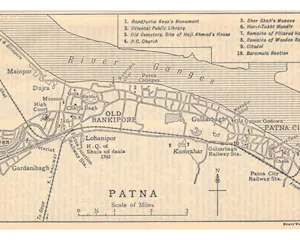Advertising awards are destroying print advertising: MG Parameswaran
PrintWeek India speaks to MG Parameswaran, former adman and founder at Brand-Building.com, to get an overview of the current state of print advertising in India.
04 Oct 2016 | By Payal Khandelwal
The entrance lobby of the newly done up office of Brand-Building.com in Prabhadevi is adorned with seven laminated book covers. These covers of course belong to the books that the founder of this company, MG Parameswaran or Ambi as he is fondly called, has authored. One of the covers is from Ambi’s most recent release titled Nawabs, Nudes, Noodles that traces the highly fascinating evolution of Indian advertising which is intertwined with the evolution of Indian culture.

After working at places like Rediffusion Y&R, Boots Company, and UDI Yellow pages, Ambi joined what is now known as FCBUlka Advertising in 1989. While rising in ranks from VP to CEO to advisor of the agency, Ambi has worked on some of the biggest brands and campaigns in the country. After spending more than two decades at the agency, Ambi decided to call it quits. But instead of announcing any retirement plans, he started a brand new chapter in his life with his advisory company Brand-Building.com.
We meet Ambi over a cup of coffee in his new office to congratulate him and to talk about print advertising in India which – as Ambi points out – is going through its own evolution right now. Edited excerpts:
Q: What according to you would be the basic checklist by which we can gauge if a print ad is really effective or not?
MG Parameswaran (MGP): Any kind of advertising has to ultimately deliver in the marketplace. Your ad has to result either in enquiries or sale or changing the image of your brand. To a certain extent, all these will always be the metrics. However, now there is also the question that what the role of print advertising is in the current scheme of things. Earlier, we had very successful brand launches with only print campaigns. I don’t know if that will work now or why clients are not at least trying it. But one thing is for sure that print advertising is going through a big change right now. And its overall role in the context of say TV or digital medium is a game that’s still being played out.
Many FMCG brands had almost completely stopped advertising in print for a while, but I see many of them coming back now. Many e-commerce brands, which are strictly in the digital category, are spending a lot of money on print. And obviously for a reason. They probably feel that only using digital doesn’t give them access to all kinds of target audience. So there is still a lot of money going into print.
Q: That’s a very interesting point. There indeed is a renewed focus on print everywhere. Even WPP’s Martin Sorrell said last year that newspapers’ and magazines’ effectiveness is highly underestimated by marketers. But do you think that marketers and agencies in India are realising this?
MGP: Well, there are a couple of reasons for the renewed focus on print. One is that marketers are realizing that print gives you the geographical specificity which in a way television doesn’t give. And digital, if you actually dig deeper, is turning out to be quite expensive. There was an article recently that P&G is planning to move away from targeted advertising on Facebook because it has become very expensive. And that’s true. If you tell Facebook that you want women who are in 18-25 age bracket and are living in Mumbai, the cost goes just through the roof.
You might as well take an ad in The Times of India or Mid-Day instead, and it would work as effectively.
I think we (in India) are still in an age where many brand managers are solely focusing on digital. However, in other places like the US for example, there is a gradual shift towards print. The local newspapers are becoming hot there again because communities want their news in a format they can touch and feel. Things are changing.
Another problem with print advertising in India is that it’s become very directional. So many agencies create print ads only for awards. So in a sense, advertising awards are destroying print advertising by letting agencies create ads that don’t run in the media. Till a few years back, brands used to win awards for print campaigns that successfully ran on media. I started my career working on a brand called Thermax whose print campaign – that ran in The Times of India and Economic Times – won the campaign of the year at that time. But in the last ten years or so, most of the so called award-winning print campaigns haven’t run in the media. So in a sense, the entire community is choking print advertising by creating this schizophrenic world in which you create boring ads to actually run in the media and interesting ads for awards submission. And that’s a big problem.
Q: Going back to your point about the geographical specificity, in your latest book Nawab, Nudes and Noodles, you have given the example of Dalda which was one of the first Indian brand that created highly customised ads in 14 Indian languages. Do you think that brands today are actually leveraging this advantage that print offers? Are they customising enough?
MGP: I don’t think we are doing that today at all. And that’s another problem. However, if you talk to direct marketing companies, they are running 300 campaigns every months which are aimed at different target audience. But there are no too many examples like Dalda today, especially in print. Marketers are missing out on the great opportunity that print gives them.
Q: We have seen many print innovations in the recent past from various brands including Tata Motors, Volkswagen, Bru, Colgate, etc. While some of them have been gimmicky, some have been quite interesting. What are the innovations that you personally liked?
MGP: About two years ago when Tata Motors was launching Tata Zest, they did an innovation (executed by FCBUlka Advertising and Lodestar) where they gave out a key with each newspaper (The Times of India). Each key had a specific barcode, and readers could take the key to a nearby dealership for a test drive and entire into a contest to win the car. That was an outstandingly successful campaign. Tata Motors also did a recent innovation with Tiago where they gave out virtual reality glasses. I don’t know how successful that was but I heard that about 36,000 people downloaded the app associated with it, which is not bad at all.
We should definitely encourage these innovations, but not all of them work.
Volkswagen has tried it in the past. They even got into a social media mess when they gave out that buzzer and someone from their team ended up saying something objectionable on Twitter.
But overall, print allows you to do these experiments. Print innovations can be explored in a few different ways, and product sampling is one of them. Eenadu was the first newspaper in India which actually allowed you to product sampling. Then Filmfare did this nationally. And now so many newspapers do that. Again, you get a great advantage with Indian newspapers because they are directly delivered to people’s homes, and therefore your product sample easily finds its way into your target consumers’ homes. The second way to do innovation is to do a booklet or another cover. The third, which is the most irritating way, is half-sized newspapers and pamphlets sticking out of the paper. The fourth is when you allow the ad to creep into the newspaper, and when it’s done well and integrated seamlessly, it can be fantastic. And finally, I feel that classic print advertising still works.
Q: Do you think that by focusing too much on digital, agencies and brands are sort of losing focus on doing the “classic print advertising”?
MGP: I actually don’t know if agencies are actually training people to write print ads anymore. The classic writing skills have virtually disappeared. There are a very few good writers today, and agencies everywhere are struggling with this. In fact, AAAI (Advertising Agencies Association of India) had started an online copywriting course, last year, when I was the president, and we got adman Rajan Nair to pilot the program. We wished we had got at least 100 participants, but we ended up getting only 30. This is strange because there are so many young people out there who are trying to write books and blogposts but we are not able to get enough talent in print advertising.
In fact, in the last section of my recent book, I have written that the print ad of the decade was actually written 10 years ago by Alok Nanda for baby models with the headline ‘Nude Models Wanted’. It’s a brilliant print ad. We don’t see print ads like that anymore.
Q: I want to talk about another aspect of print which is the launch of print magazines by a lot of brands. There aren’t too many brands doing this in India, but internationally this trend has been on an upswing. What are you views on this?
MGP: Not sure what the gameplan is in this context. I understand that if you are a digital brand, you want to create some kind of a touch and feel experience for your consumers. That’s why Amazon went ahead and started a physical bookstore. And I am not surprised an online fashion portal like Jabong launched a print magazine (Juice). The problem is that producing a magazine costs a lot and they have a shelf life. So instead of magazines, the online brands might want to look at something slightly more cost effective, long lasting and more useful.

Q: Lastly, what are some of the most interesting print ads you have seen in the last three years?
MGP: Some of the heavy copy ads for The Times of India are really very good. I also like a few campaigns by Rustamjee Builders. Alok Nanda’s work on Lodha always has a nice sense of humour. Mahindra Scorpio’s print advertising has always been good and classic. These are some of the print campaigns in the last few years that have got my attention. On the other hand, most of the e-commerce print ads are merely catalogues.














 See All
See All